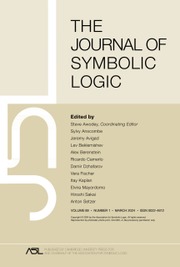Crossref Citations
This article has been cited by the following publications. This list is generated based on data provided by
Crossref.
Abeshev, K. Sh.
Badaev, S. A.
and
Mustafa, M.
2014.
Families Without Minimal Numberings.
Algebra and Logic,
Vol. 53,
Issue. 4,
p.
271.
Bazhenov, N. A.
2015.
The Branching Theorem and Computable Categoricity in the Ershov Hierarchy.
Algebra and Logic,
Vol. 54,
Issue. 2,
p.
91.
Ospichev, S. S.
2016.
Computable Families of Sets in the Ershov Hierarchy Without Principal Numberings.
Journal of Mathematical Sciences,
Vol. 215,
Issue. 4,
p.
529.
Herbert, Ian
Jain, Sanjay
Lempp, Steffen
Mustafa, Manat
and
Stephan, Frank
2019.
Reductions between types of numberings.
Annals of Pure and Applied Logic,
Vol. 170,
Issue. 12,
p.
102716.
Bazhenov, N. A.
and
Kalmurzaev, B. S.
2019.
Rogers Semilattices for Families of Equivalence Relations in the Ershov Hierarchy.
Siberian Mathematical Journal,
Vol. 60,
Issue. 2,
p.
223.
Bazhenov, Nikolay
Mustafa, Manat
and
Ospichev, Sergei
2019.
Computing with Foresight and Industry.
Vol. 11558,
Issue. ,
p.
96.
Bazhenov, Nikolay
Mustafa, Manat
and
Ospichev, Sergei
2020.
Theory and Applications of Models of Computation.
Vol. 12337,
Issue. ,
p.
1.
Bazhenov, N. A.
Mustafa, M.
and
Ospichev, S. S.
2021.
On Universal Pairs in the Ershov Hierarchy.
Siberian Mathematical Journal,
Vol. 62,
Issue. 1,
p.
23.
Bazhenov, N. A.
Mustafa, M.
and
Tleuliyeva, Zh.
2021.
Theories of Rogers Semilattices of Analytical Numberings.
Lobachevskii Journal of Mathematics,
Vol. 42,
Issue. 4,
p.
701.
Faizrahmanov, Marat
2022.
Extremal numberings and fixed point theorems.
Mathematical Logic Quarterly,
Vol. 68,
Issue. 4,
p.
398.
Bazhenov, Nikolay
Mustafa, Manat
and
Tleuliyeva, Zhansaya
2022.
Rogers semilattices of limitwise monotonic numberings.
Mathematical Logic Quarterly,
Vol. 68,
Issue. 2,
p.
213.
Badaev, S. A.
and
Goncharov, S. S.
2022.
Rogers Semilattices with Least and Greatest Elements in the Ershov Hierarchy.
Algebra and Logic,
Vol. 61,
Issue. 3,
p.
225.
Bazhenov, Nikolay
Mustafa, Manat
and
Ospichev, Sergei
2022.
Rogers semilattices of punctual numberings.
Mathematical Structures in Computer Science,
Vol. 32,
Issue. 2,
p.
164.
Файзрахманов, Марат Хайдарович
and
Faizrahmanov, Marat Khaidarovich
2023.
Две теоремы о минимальных обобщенно-вычислимых нумерациях.
Вестник Московского университета. Серия 1: Математика. Механика,
p.
28.
Faizrahmanov, M. Kh.
2023.
Two Theorems on Minimal Generalized Computable Numberings.
Moscow University Mathematics Bulletin,
Vol. 78,
Issue. 3,
p.
136.
Nurlanbek, D. D.
2023.
ON THE EXISTENCE OF UNIVERSAL NUMBERINGS.
Herald of the Kazakh-British technical university,
Vol. 20,
Issue. 1,
p.
14.
Bazhenov, Nikolay
Mustafa, Manat
and
Nurakunov, Anvar
2024.
On Concept Lattices for Numberings.
Tsinghua Science and Technology,
Vol. 29,
Issue. 6,
p.
1642.
Faizrahmanov, M. Kh.
2024.
A Family with a Single Minimal but Not Least Numbering.
Siberian Mathematical Journal,
Vol. 65,
Issue. 2,
p.
381.

